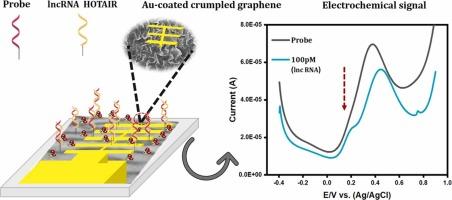An electrochemical probe for the ultrasensitive detection of long non-coding RNA biomarkers
IF 3.7
1区 化学
Q1 CHEMISTRY, ANALYTICAL
引用次数: 0
Abstract
Long non-coding RNAs (lncRNAs) are cutting-edge genome sequences of non-coding RNA that have emerged as key gene expression regulators. Homeobox transcript antisense intergenic RNA (HOTAIR) is an lncRNA diagnostic biomarker that directly affects apoptosis regulation and is associated with malignant cancer. Therefore, HOTAIR ultrasensitive detection is vastly crucial. In this study, we constructed a robust biosensor based on an Au-crumpled graphene/polystyrene (PS) substrate for sensing HOTAIR. High-quality chemical vapor deposition (CVD)-grown graphene was attached to the PS substrate, and heated crumpled graphene was formed through physical stacking forces. Subsequently, the gold was uniformly coated using the thermal evaporation method to enhance sensitivity, and the specimen was treated with a low-damage plasma treatment to induce active oxygen functionalization at the surface. The single-stranded DNA probe was then immobilized to the modified electrode, and the device was characterized. A linear working in the range of 1 fM–100 pM was determined with an ultralow detection limit of 149 aM. The biosensor detects HOTAIR selectively in the presence of base-mismatched sequences, and its suitability for human serum analysis was assessed. Thus, this system could be used to monitor HOTAIR as a diagnostic biomarker to detect early cancer and assess disease progression.

一种用于超灵敏检测长链非编码RNA生物标志物的电化学探针
长链非编码RNA (lncRNAs)是非编码RNA的前沿基因组序列,已成为关键的基因表达调控因子。同源盒转录反义基因间RNA (HOTAIR)是一种直接影响细胞凋亡调控的lncRNA诊断性生物标志物,与恶性肿瘤有关。因此,HOTAIR的超灵敏检测非常重要。在这项研究中,我们构建了一个基于金皱巴巴的石墨烯/聚苯乙烯(PS)衬底的鲁棒生物传感器来检测HOTAIR。将化学气相沉积(CVD)生长的高质量石墨烯附着在PS衬底上,并通过物理堆叠力形成加热皱化的石墨烯。随后,用热蒸发法均匀涂覆金以提高灵敏度,并用低损伤等离子体处理试样,在表面诱导活性氧官能化。然后将单链DNA探针固定在修饰电极上,并对该装置进行表征。在1 fM-100 pM范围内线性工作,超低检出限为149 aM。该生物传感器在存在碱基错配序列时选择性检测HOTAIR,并评估其用于人血清分析的适用性。因此,该系统可用于监测HOTAIR作为诊断性生物标志物,以检测早期癌症和评估疾病进展。
本文章由计算机程序翻译,如有差异,请以英文原文为准。
求助全文
约1分钟内获得全文
求助全文
来源期刊

Sensors and Actuators B: Chemical
工程技术-电化学
CiteScore
14.60
自引率
11.90%
发文量
1776
审稿时长
3.2 months
期刊介绍:
Sensors & Actuators, B: Chemical is an international journal focused on the research and development of chemical transducers. It covers chemical sensors and biosensors, chemical actuators, and analytical microsystems. The journal is interdisciplinary, aiming to publish original works showcasing substantial advancements beyond the current state of the art in these fields, with practical applicability to solving meaningful analytical problems. Review articles are accepted by invitation from an Editor of the journal.
 求助内容:
求助内容: 应助结果提醒方式:
应助结果提醒方式:


